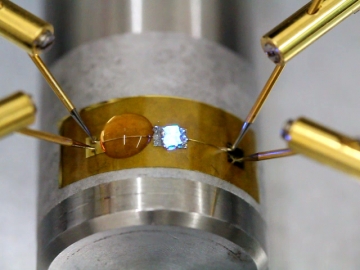Researchers create self-reconstructive metal wire utilizing electric field trapping of gold nanoparticles

Device Demonstration: A device with a LED chip placed on top is attached to a polyamide board. 3 volts of electricity are applied to the board and initiate self-reconstruction. Copyright : Waseda University
Professor Eiji Iwase (Faculty of Science and Engineering) and 1st year graduate student Tomoya Koshi (Graduate School of Fundamental Science and Engineering) have created a metal wire that can reconstruct itself utilizing electric field trapping of gold nanoparticles.
The reconstructive ability achieved in this research is expected to impact the hard-wiring of flexible devices and temperature-prone substrate electronics.
The content of this research was presented at the 28th International Conference on Micro Electro Mechanical Systems (January 18-22, 2015). The research presentation was selected as an “Outstanding Oral Paper Award Finalist” and garnered much interest.
Presentation Title: Tomoya Koshi, Eiji Iwase, “Self-healing Metal Wire using an Electric Field Trapping of Gold Nanoparticles for Flexible Devices,” Proceedings of the 28th IEEE International Conference on Micro Electro Mechanical Systems (MEMS2015), pp. 81-84, Estoril, Portugal, January 18-22, 2015.
Associated links
Waseda University's article
Media Contact
More Information:
http://www.researchsea.comAll latest news from the category: Power and Electrical Engineering
This topic covers issues related to energy generation, conversion, transportation and consumption and how the industry is addressing the challenge of energy efficiency in general.
innovations-report provides in-depth and informative reports and articles on subjects ranging from wind energy, fuel cell technology, solar energy, geothermal energy, petroleum, gas, nuclear engineering, alternative energy and energy efficiency to fusion, hydrogen and superconductor technologies.
Newest articles

Silicon Carbide Innovation Alliance to drive industrial-scale semiconductor work
Known for its ability to withstand extreme environments and high voltages, silicon carbide (SiC) is a semiconducting material made up of silicon and carbon atoms arranged into crystals that is…

New SPECT/CT technique shows impressive biomarker identification
…offers increased access for prostate cancer patients. A novel SPECT/CT acquisition method can accurately detect radiopharmaceutical biodistribution in a convenient manner for prostate cancer patients, opening the door for more…

How 3D printers can give robots a soft touch
Soft skin coverings and touch sensors have emerged as a promising feature for robots that are both safer and more intuitive for human interaction, but they are expensive and difficult…





















